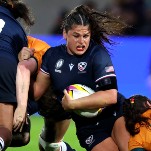The Female Athletes Who Are Damned If They Do, Damned If They Don't
LatestIn the past month, religious women have been prevented from participating in soccer, basketball, and weightlifting — all because their faith dictates they cover their heads, necks, arms, legs, or some combination thereof. If three makes a trend, then it looks like we’re on the way to seeing an unofficial consensus from athletics organizations about whether devoutly religious women can play sports at all.
Basketball player Naama Shafir was barred from playing for the Israeli National Team in the European women’s basketball championship because as an Orthodox Jew she is required to wear a t-shirt to cover her shoulders during play. The University of Toledo, where Shafir is a student athlete, has always allowed her to wear a t-shirt under her jersey. While that kind of accommodating tomfoolery might be okay in the states, officials at the Munich-based international basketball association, FIBA, are being pretty German about the whole thing, having strictly forbidden her to participate if she won’t compromise her religious beliefs by removing the t-shirt: “The global rules of the game clearly state that a team must be uniformly dressed, and the rules must always be upheld.” They’re not even bothering with the safety rationale — harsh.
Although Shafir has previously gotten special permission from her rabbi to play on the Sabbath, she is not willing to further compromise her beliefs in order to participate in the tournament. Rules are rules and religion is religion, but isn’t there some kind of compromise here? There’s gotta be some kind of nude upper-arm stocking at American Apparel that would do the trick.
-

-

-

-

-

-

-

-

-

-

-

-

-

-

-

-

-

-

-

-

-

-

-

-

-

-

-

-

-

-

-

-

-

-

-

-

-

-

-

-








































